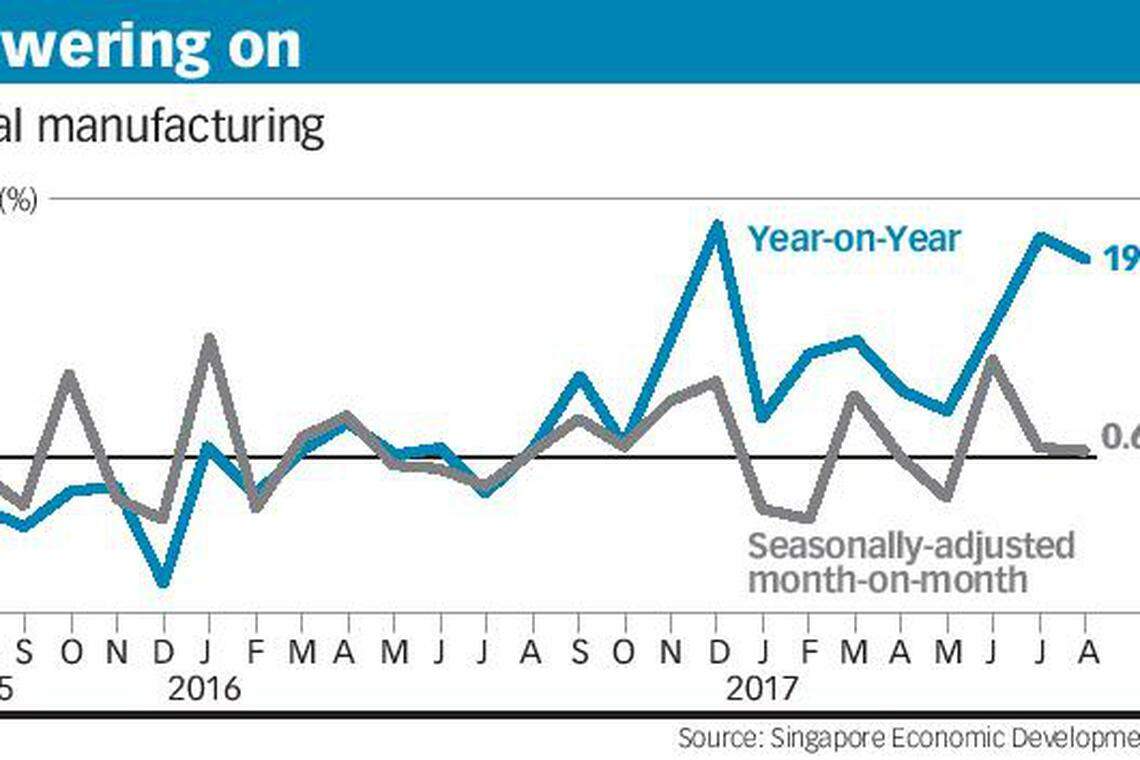August output powers ahead; 19% jump expected to boost Q3 GDP
Growth just a shade off year's high in July; electronics and biomed lead expansion across all sectors except general manufacturing
Singapore
SINGAPORE'S factory output extended its winning streak of double-digit expansion for the third consecutive month, boosting the upside for third-quarter economic growth.
Industrial production jumped 19.1 per cent year on year in August, powered by the still-strong key electronics cluster and bolstered by double-digit growth in the volatile biomedical manufacturing cluster.
The manufacturing sector, which contributes about 20 per cent to the economy, remains a strong growth driver this year.
The latest data released by the Economic Development Board on Tuesday showed that August's print beat market consensus, but was lower than the previous month's revised 21.2 per cent, which was a record high this year.
Private sector economists polled by Bloomberg before the data was released were expecting factory output to grow at a median estimate of 16 per cent in August.
With the biomedical manufacturing stripped out, industrial production grew 17.8 per cent year on year.
On a month-on-month basis, factory output increased a seasonally-adjusted 0.6 per cent in August. Excluding biomedical manufacturing, output fell 2.5 per cent.
Notably, all clusters posted positive growth, except general manufacturing industries, which saw output fall 0.6 per cent in August.

OCBC Bank economist Selena Ling said that this means the domestic manufacturing recovery has developed beyond just solely an electronics story.
She said: "This lends credence to our view that the engines of growth are broadening and bodes well for growth momentum going into end-2017 and into 2018.
"Moreover, at the current levels for the manufacturing index, the base for September to November 2016 does not appear particularly challenging."
Electronics manufacturing output jumped 38.7 per cent versus a year ago, as the semiconductors segment surged 55.7 per cent.
UOB Bank economist Francis Tan said the semiconductor segment had been growing at a double-digit pace for the past 18 consecutive months, achieving an average growth rate of 45.5 per cent year-on-year during those months.
He said: "The robust expansion highlights a cyclical rise in global demand, and not just due to a low base."
Computer peripherals as well as infocomms and consumer electronics segments grew 20.1 per cent and 6.8 per cent, respectively. This offset output decline of 8.3 per cent in other electronic modules and components; and a fall of 24.7 per cent in data storage output.
Gains in the electronics cluster spilled over to the precision engineering cluster, which posted a 10.7 per cent output growth - the 13th consecutive month of expansion.
The precision modules and components segment grew 16.6 per cent, while higher export demand for semiconductor-related equipment led to a 7.3 per cent expansion in the machinery and systems segment.
Biomedical manufacturing output recorded robust growth of 25.1 per cent, led by the medical technology (30.8 per cent) and pharmaceuticals (23.1 per cent) segments.
The strong growth in the biomedical manufacturing cluster was partly due to the low base in pharmaceutical output in August 2016 - the lowest level for the whole of last year.
"Over in the next few months till end of this year, the tide may turn as it was a double-digit high base last year," said Mr Tan, noting that the cluster may contract over the September to December 2017 period.
Transport engineering output rose for the third consecutive month to gain 5.5 per cent. Land transport output grew 31.1 per cent as it produced more motor vehicle parts; aerospace output gained 27.4 per cent as it did more repair and maintenance work from commercial airlines.
But the marine and offshore engineering segment continues to be a drag as output fell 15.8 per cent, extending its on-year decline to the 30th consecutive month.
The chemicals cluster output gained 1.8 per cent, led mainly by the petrochemicals segment which rose 16.4 per cent due to the lower base in August 2016 as some plants shut down for maintenance then. The petroleum segment gained 4.9 per cent, while the specialties (minus 4.3 per cent) and other chemicals (minus 5 per cent) segments declined.
Indeed, electronics will likely remain in the driving seat while biomedical is the swing factor, said DBS Bank senior economist Irvin Seah.
Mr Seah said: "Importantly, the robust expansion in electronics comes amid the improvement in global economic environment.
"Growth in China has been resilient despite earlier concern of slower growth. And economic momentum in the US and Eurozone has also been picking up. Such phenomenon is expected to persist in the near term, which will be manifested in healthy industrial production and export numbers for Singapore."
However, UOB's Mr Tan noted the need to be watchful of headwinds and uncertainties facing growth due to the upcoming elections in several European countries and policy surprises from the US administration.
He said: "Although we remain optimistic in the continuing growth for the electronics and precision engineering clusters in 2017, we believe the double-digit growth for semiconductor production may slow into the single digits as we proceed towards the end of the year and into 2018, due to base effects and a slower second half capex (capital expenditure) growth expected in China."
BT is now on Telegram!
For daily updates on weekdays and specially selected content for the weekend. Subscribe to t.me/BizTimes
Economy & Policy
Singapore’s inflation eases more than expected in March, with headline inflation at 2.5-year low
8 in 10 firms in S-E Asia, Greater China positive about business environment: UOB survey
Flexi-work request guidelines not meant to prescribe blanket outcomes for employers or influence hiring of workforce: SNEF
Daily Debrief: What Happened Today (Apr 23)
Daily Debrief: What Happened Today (Apr 24)
Daily Debrief: What Happened Today (Apr 22)
